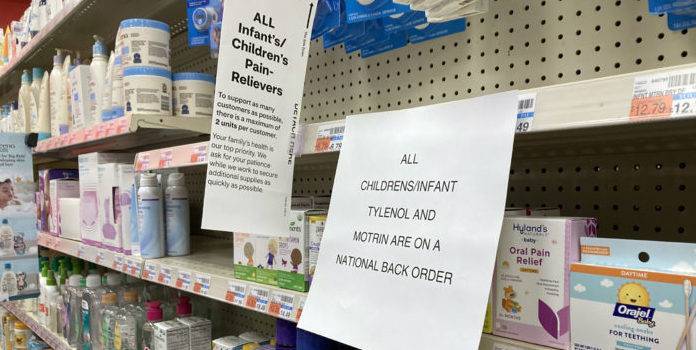(Headline USA) Caring for sick children has become extra stressful recently for many U.S. parents in the Biden era due to shortages of Children’s Tylenol and other medicines.
An unusually fast start to the annual U.S. flu season, plus a spike in other respiratory illnesses, created a surge in demand for fever relievers and other products people can buy without a prescription.
“There are more sick kids at this time of year than we have seen in the past couple years,” said Dr. Shannon Dillon, a pediatrician at Riley Children’s Health in Indianapolis.
Aside from over-the-counter products, the prescription antibiotic amoxicillin also is in short supply due to increased demand, according to the Food and Drug Administration. The drug is often used to treat nose and throat infections in children.
Doctors and other experts say the problem could persist through the winter cold-and-flu season but should not last as long as other recent shortages of baby formula or prescription drugs.
They also say parents have alternatives if they encounter empty store shelves.
“At this point, it’s more like toilet paper at the beginning of the pandemic,” Dillon said “You just have to look in the right place at the right time.”
Drugmaker Johnson & Johnson says it is not experiencing widespread shortages of Children’s Tylenol, but the product may be “less readily available” at some stores. The company said it is running its production lines around the clock.
In the meantime, CVS Health has placed a two-product limit on all children’s pain relief products bought through its pharmacies or online.
Walgreens is limiting customers online to six purchases of children’s over-the-counter fever reducing products. That limit doesn’t apply in stores.
Manufacturers say there are no widespread national shortages of these medications, according to the Consumer Healthcare Products Association, so other stores may have better supplies.
Moreover, generic versions of brand-name products are “perfectly safe and often a much more affordable option,” Dillon said.
A family doctor may know which stores have decent supplies and may be able to tell parents whether they can try alternatives like crushing the proper dose of a pill version and mixing it with food or chocolate syrup.
Doctors say parents or caregivers should not try this on their own, because determining proper doses for children can be tricky.
“You don’t need to experiment at home,” said Dr. Sarah Nosal, a South Bronx family physician. “Your family doctor wants to talk to you and see you.”
Doctors also caution that fevers don’t always have to be treated. They are a body’s natural defense against infection, and they make it hard for a virus to replicate.
Dillon noted, for instance, that a fever may not be intrinsically harmful to older children.
However, parents should take a newborn under 2 months old to the doctor if the child has a fever of 100.4 degrees or more. And doctors say any child with a fever should be monitored for behavior changes.
Shortages might last in some communities until early next year.
Resolving them can depend on whether there are enough workers at warehouses and stores to deliver the product and stock the shelves, noted Erin Fox.
She researches drug shortages and is the senior pharmacy director at University of Utah Health, which runs five hospitals.
Fox said there are no problems at factories or a lack of ingredients contributing to current shortages. Those obstacles can lead to long supply disruptions.
“I don’t expect this to last a year or more like some of our other shortages do,” she said.
Adapted from reporting by the Associated Press

